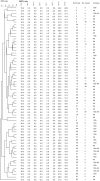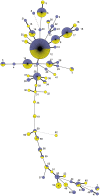Comparison of subtypes of Listeria monocytogenes isolates from naturally contaminated watershed samples with and without a selective secondary enrichment
- PMID: 24651315
- PMCID: PMC3961389
- DOI: 10.1371/journal.pone.0092467
Comparison of subtypes of Listeria monocytogenes isolates from naturally contaminated watershed samples with and without a selective secondary enrichment
Abstract
Two enrichment methods for Listeria monocytogenes using Immuno Magnetic Separation (IMS) were tested to determine if they selected the same subtypes of isolates. Both methods used a non-selective primary enrichment and one included subculture in Fraser Broth, while the other involved direct plating of IMS beads. Sixty-two naturally contaminated watershed samples from the Central California Coast were used as a source of L. monocytogenes, and subtype diversity was measured by serotype and Multiple Number Variable Tandem Repeat Analysis (MLVA). Three different serotypes were detected from both methods with serotype 4b strains making up 87% of the isolates, serotype 1/2a making up 8%, and serotype 1/2b making up 5%. The data suggest that serotype 1/2a strains were more likely to be isolated from the Fraser Broth culture method. Sixty-two different MLVA types were detected and the more common MLVA types were detected by both culture methods. Forty-three MLVA types were detected only from one culture method or the other, while 19 types were detected from both culture methods. The most common MLVA type-12 was detected in 33 of the 62 water samples, and represented 31% of the isolates from both culture methods. This limited study provides evidence that using both enrichment culture methods allowed for detection of a greater diversity of isolates among the samples than the use of one method alone, and that a wide diversity of L. monocytogenes strains exist in this watershed.
Conflict of interest statement
Figures


References
-
- Perry C, Donnelly CW (1990) Incidence of Listeria monocytogenes in silage and its subsequent control by specific and nonspecific antagonism. J Food Prot 53: 642–647. - PubMed
Publication types
MeSH terms
Substances
Grants and funding
LinkOut - more resources
Full Text Sources
Other Literature Sources
Medical

